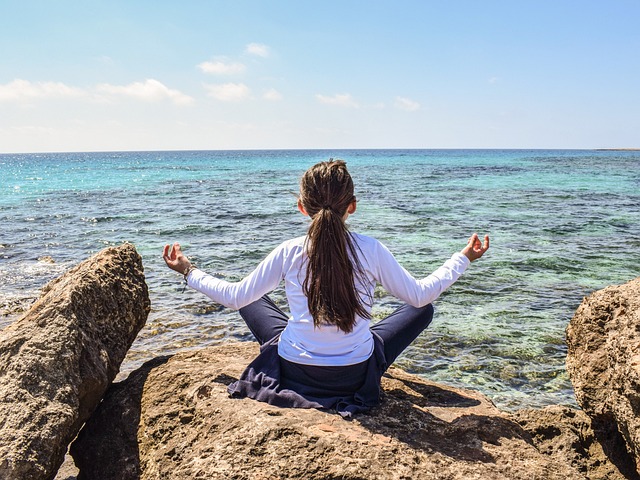Ocean Waves Meditation: The Power of Peace
Ocean Waves Meditation: In today’s fast-paced and stressful world, where constant distractions and demands can leave us feeling overwhelmed and disconnected, the search for inner peace and tranquility has become increasingly vital. Ocean wave meditation, as a result, various meditation techniques have gained popularity as effective tools for finding solace and restoring balance in our lives. One such technique that has captured the attention of many is ocean wave meditation.
This article delves into the science behind meditation, shedding light on the profound impact it can have on our mental and emotional well-being. Scientific research has shown that meditation has numerous positive effects on the mind and body, including reducing stress, improving focus and attention, enhancing emotional well-being, and promoting overall mental health. By understanding the scientific basis of meditation, we can appreciate its potential to transform our lives.
The Science Behind Meditation and Its Impact on the Mind
Meditation has a rich history and cultural significance that spans various traditions and civilizations. This section delves into the origins of meditation, exploring its roots in ancient practices and its integration into different cultures worldwide. In our increasingly distracted world, cultivating focus and attention is crucial. This section explores how meditation practices, including ocean waves meditation, can enhance our ability to concentrate and stay present.
It delves into the neuroscience behind meditation, highlighting how it can improve cognitive functions, increase attention span, and enhance overall mental clarity. Emotional well-being is an essential aspect of mental health. This section delves into the emotional benefits of meditation, such as cultivating mindfulness, promoting self-awareness, and fostering emotional resilience. It explores how meditation can help regulate emotions, reduce negative thoughts, and enhance overall emotional well-being.
Meditation is not just a temporary escape; it is a practice that can promote long-term mental health. This section discusses the broader impact of regular meditation on our overall well-being. It explores how meditation can improve self-esteem, boost creativity, enhance problem-solving skills, and foster a positive outlook. By incorporating meditation into our daily routine, we can experience lasting improvements in our mental health.

The Benefits of Ocean Waves Meditation
Ocean wave meditation, specifically, offers unique benefits due to its connection with nature. This section explores the advantages of this particular form of meditation, such as inducing a sense of calmness, reducing anxiety, improving sleep quality, enhancing creativity, and fostering a deeper connection with oneself and the environment.
1. Inducing Calmness and Relaxation through Ocean Waves Meditation
Ocean waves meditation offers a unique experience of calmness and relaxation. This section explores how the rhythmic sound of ocean waves can soothe the mind, reduce stress, and induce deep relaxation. It highlights the therapeutic effects of immersing oneself in the tranquil ambiance of the ocean.
2. Reducing Anxiety and Cultivating Inner Peace with Ocean Waves
Anxiety is a common mental health challenge faced by many. This section focuses on how ocean wave meditation can be particularly effective in reducing anxiety levels. It explores how the gentle ebb and flow of the waves can help calm racing thoughts, alleviate tension, and cultivate inner peace.
3. Improving Sleep Quality through the Soothing Sounds of the Ocean
Sleep plays an important role in our overall well-being. This section discusses how ocean wave meditation can improve sleep quality. It explores how the soothing sounds of the ocean can create a peaceful environment, promote relaxation, and help individuals achieve more restful and rejuvenating sleep.
4. Enhancing Creativity and Inspiring a Deeper Connection with Nature
Ocean wave meditation can enhance creativity and foster a deeper connection with nature. This section explores how immersing oneself in the sounds of the ocean can stimulate the imagination, unlock creative potential, and inspire a sense of awe and wonder for the natural world.
5. Nurturing Self-Reflection and Finding Balance with Ocean Waves
Self-reflection is an essential aspect of personal growth and well-being. This section discusses how ocean wave meditation can facilitate self-reflection and introspection. It explores how the serene environment of the ocean can provide a space for contemplation, self-discovery, and finding balance in life.
How to Practice Ocean Waves Meditation Effectively
To fully experience the benefits of ocean wave meditation, it is essential to practice it effectively. This section provides practical tips and techniques for beginners and experienced practitioners alike. It covers finding a comfortable posture, focusing on the sound and rhythm of ocean waves, incorporating deep breathing exercises, and maintaining a relaxed state of mind.
1. Finding a Comfortable Posture for Ocean Waves Meditation
A comfortable posture is essential for successful meditation practice. This section guides finding a suitable posture for ocean wave meditation, whether sitting or lying down, to ensure physical comfort and relaxation.
2. Focusing on the Sound and Rhythm of Ocean Waves
The sound and rhythm of ocean waves are central to this meditation practice. This section explores techniques for focusing on the soothing sounds of the waves, allowing them to become the focal point of attention and guiding the mind into deep relaxation.
3. Incorporating Deep Breathing Exercises for a Deeper Experience
Deep breathing exercises can enhance the benefits of ocean wave meditation. This section introduces various breathing techniques that can be incorporated into the practice, such as diaphragmatic breathing or alternate nostril breathing, to deepen relaxation and promote a sense of inner calm.
4. Cultivating a Relaxed State of Mind during Ocean Waves Meditation
A relaxed state of mind is crucial for a fruitful meditation session. This section provides tips and strategies for cultivating a relaxed mental state during ocean waves meditation, including letting go of distractions, embracing the present moment, and cultivating a non-judgmental attitude towards thoughts and emotions.
4. Exploring Guided Ocean Waves Meditation Techniques
Guided meditation can be a helpful tool for beginners or those seeking additional guidance. This section explores the availability of guided ocean waves meditation resources, such as audio recordings or smartphone applications, that can assist individuals in their meditation practice and provide a structured experience.

Creating a Peaceful Environment for Meditation
The environment we meditate in plays a crucial role in our overall experience. This section discusses creating a serene and peaceful environment for ocean wave meditation. It includes suggestions for choosing the right location, minimizing distractions, using calming scents or essential oils, and incorporating soft lighting or natural elements to enhance the ambiance.
1. Choosing the Right Location
Selecting the right location is crucial for creating a peaceful environment. Find a space that is quiet, comfortable, and free from distractions. It could be a dedicated meditation room, a corner of your home, or a secluded natural spot. Consider the atmosphere and energy of the location, ensuring it aligns with your intention for meditation.
2. Minimizing Distractions
Distractions can disrupt your focus and hinder the effectiveness of your meditation practice. Before you begin, eliminate any potential distractions. Turn off or silence your electronic devices, such as phones or tablets, to avoid interruptions. If you’re meditating at home, inform your family members or roommates about your practice so they can respect your need for solitude and quiet during that time.
3. Using Calming Scents or Essential Oils
Aromatherapy can enhance the ambiance and deepen your relaxation during meditation. Consider using calming scents or essential oils that promote a sense of tranquility and peace. Lavender, chamomile, or sandalwood are popular for their soothing properties. Use a diffuser or place a few drops of essential oil on a cotton ball nearby to infuse the air with a gentle fragrance.
4. Incorporating Soft Lighting
Soft lighting can create a serene atmosphere for meditation. Dim the lights or use natural light sources, such as candles or soft lamps, to create a gentle and soothing ambiance. Harsh or bright lights can be distracting, so opt for softer, diffused lighting that promotes relaxation and a sense of calm.
5. Integrating Natural Elements
Bringing elements of nature into your meditation space can foster a deeper connection with the environment and enhance your experience. Consider incorporating natural elements such as plants, seashells, or stones. These elements can evoke a sense of grounding and harmony, reminding you of the interconnectedness between yourself and the natural world.
6. Creating a Comfortable Meditation Space
Ensure that your meditation space is comfortable and conducive to relaxation. Use cushions, blankets, or a meditation mat to create a cozy and supportive seating arrangement. Pay attention to your posture and choose a position that allows you to sit comfortably for the duration of your practice. Being physically at ease will help you focus more fully on your meditation.
Maximizing the Effects of Ocean Waves Meditation for Mental Wellness
Ocean wave meditation is a powerful practice that can profoundly affect our mental well-being. While simply listening to the soothing sounds of the waves can bring a sense of calmness and relaxation, some additional techniques and practices can be combined with ocean wave meditation to maximize its benefits for our mental wellness.
One technique to enhance the effects of ocean wave meditation is visualization. As you listen to the rhythmic sounds of the waves, imagine yourself on a serene beach, feeling the gentle breeze and the sun’s warmth.
Affirmations are another powerful tool to maximize the effects of ocean wave meditation. Journaling is a complementary practice that can deepen the effects of ocean wave meditation. After each meditation session, take a few moments to reflect on your experience and write down any insights, emotions, or thoughts that arise.
Self-reflection and self-care are essential components of maximizing the effects of ocean wave meditation. Take time outside your meditation practice to engage in activities that bring you joy, practice self-care rituals, and prioritize your mental and emotional well-being.
Engaging in activities that nourish your soul, such as spending time in nature, practicing mindfulness, or engaging in creative pursuits, can complement your meditation practice and support your overall mental wellness. By incorporating self-reflection and self-care into your daily life, you can extend the benefits of ocean waves meditation beyond your meditation sessions and create a more balanced and fulfilling life.

Incorporating Ocean Waves Meditation into Your Daily Routine
Consistency is crucial when reaping the full benefits of ocean wave meditation. To make this practice a regular part of your daily routine, it is important to establish a plan and find strategies that work for you. Here are some practical tips to help you incorporate ocean wave meditation into your daily life:
1. Find a Regular Time Slot
Choose a time slot that works best for you to dedicate to your meditation practice. It could be in the morning, during a lunch break, or in the evening before bed. Select a time to commit to your practice without feeling rushed or interrupted. By establishing a consistent time, you create a habit and make it easier to integrate meditation into your daily routine.
2. Set Reminders
Initially, it can be helpful to set reminders to prompt you to meditate. Use alarms on your phone, calendar notifications, or meditation apps to remind you to take a few moments and engage in ocean waves meditation. These reminders serve as gentle nudges to prioritize your practice and ensure that you remember to make time for it amidst the busyness of daily life.
3. Building Your Practice
If you are new to meditation or have a busy schedule, it can be beneficial to start with shorter meditation sessions and gradually increase the duration over time. Begin with just a few minutes of ocean waves meditation and gradually extend the length as you become more comfortable and accustomed to the practice. Remember, consistency is more important than duration, so even a few minutes of daily meditation can have a positive impact on your well-being.
4. Find Accountability Partners or Meditation Groups
Finding accountability partners or joining meditation groups can provide added motivation and support in incorporating ocean waves meditation into your daily routine. Connect with individuals who share your passion for meditation and are on a similar journey. You can share your progress, discuss challenges, and inspire others to stay committed to your practice. Being part of a community can create a sense of accountability and provide a supportive environment for your meditation journey.
Conclusion
Embrace the Power of Peace through Ocean Waves Meditation In conclusion. Ocean waves meditation offers a powerful and accessible pathway to inner peace and enhanced mental well-being. By understanding the science behind meditation, harnessing the benefits of ocean waves, practicing effectively, creating a peaceful environment, maximizing its effects, and incorporating it into our daily lives, we can truly embrace the power of peace and experience the transformative effects of this ancient practice.
Remember, finding peace is a personal journey, and ocean wave meditation can be a valuable tool to guide you. So, take a deep breath, let the soothing sounds of the waves wash over you, and embark on a path towards a calmer, more centered mind.







